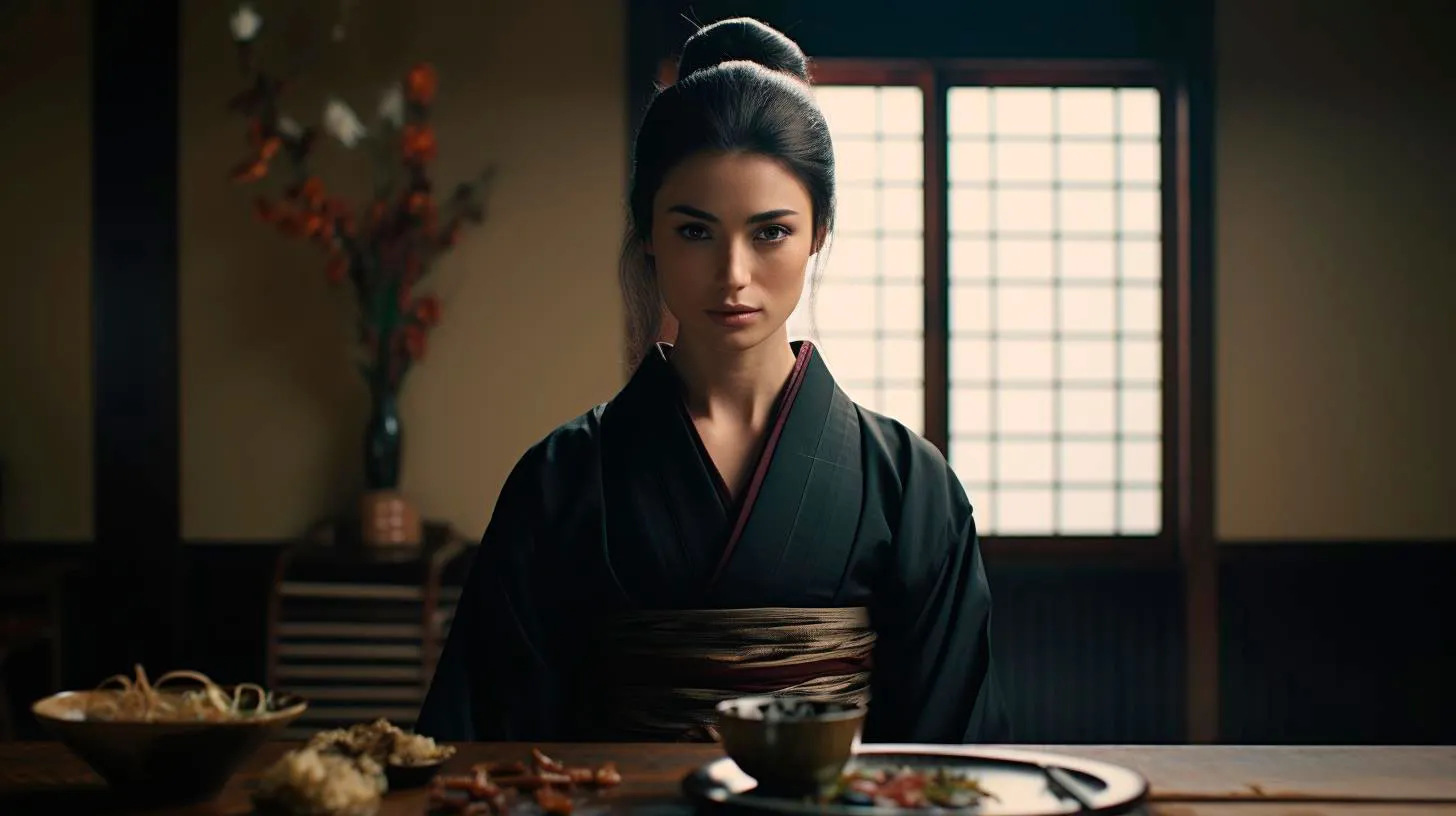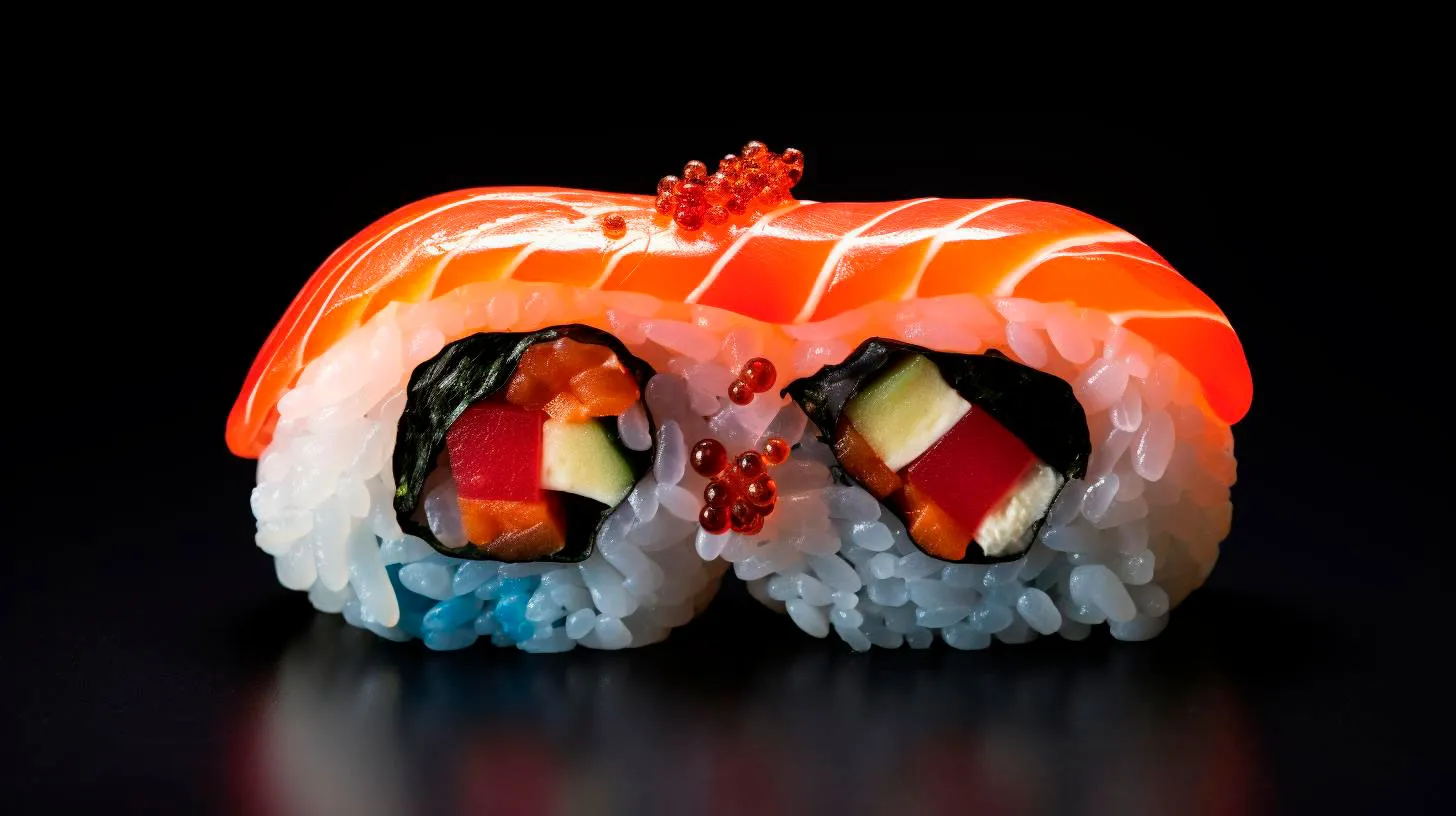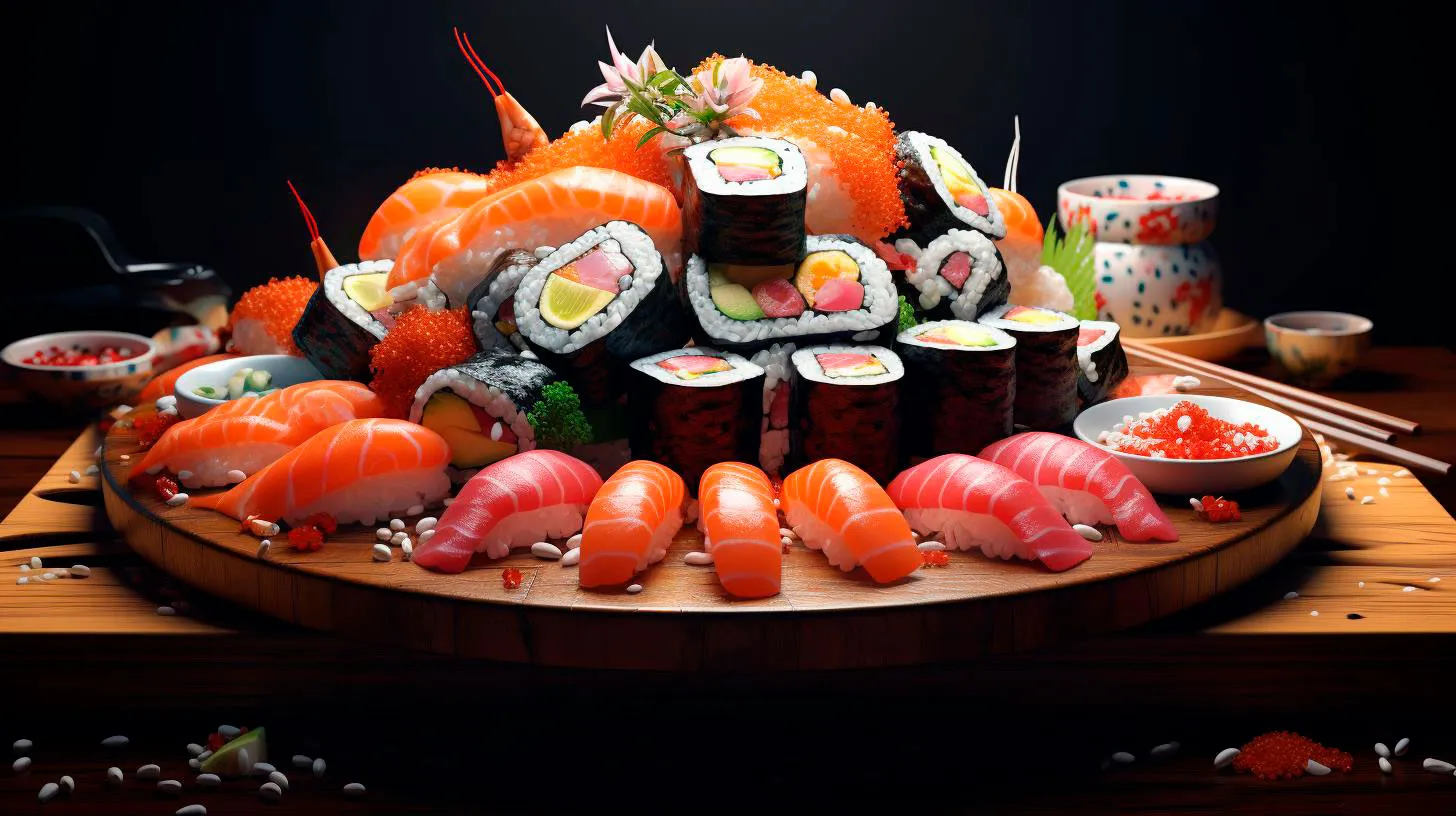The Science Behind Color: How it Affects Sushi Visual Appeal
Let’s delve into the science behind color and how it affects the visual appeal of sushi.
The Importance of Color in Food Presentation
The art of food presentation is not limited to the arrangement of ingredients on a plate. The use of colors harmoniously is equally essential in creating an appetizing experience for the diner. Colors have psychologically proven effects that elicit emotions and influence our perception of taste and flavors.
When it comes to sushi, vibrant colors are meticulously incorporated to enhance its visual appeal. Each color has a specific role in elevating the overall presentation and sensory experience for the diner. Let’s explore some of the key colors used in sushi and their effects:
1. Vibrant Red: Tuna and Salmon
Tuna and salmon, two popular fish used in sushi, possess a vibrant red color. This hue owes its intensity to the presence of carotenoids, a pigment found in marine life. The bright red color not only indicates freshness but also stimulates the appetite. The richness in color triggers the brain’s visual recognition, increasing the anticipation and excitement for the sushi roll.
2. Natural Green: Cucumber and Avocado
Cucumber and avocado are often used as fillings in sushi rolls. Their fresh, natural green color provides a pleasing contrast against the rice and fish. Green color is known to create a sense of freshness and vitality. Additionally, the green color is associated with health and well-being, making rolls with cucumber and avocado an attractive choice for health-conscious diners.
3. Earthy Brown: Seaweed
Seaweed, commonly used to wrap sushi rolls, introduces earthy brown tones to the presentation. The deep, dark color of seaweed provides a visual anchor to the vibrant ingredients inside the roll. Brown colors tend to evoke a feeling of stability and reliability. Seaweed’s presence not only enhances the sushi’s appearance but also adds texture and umami flavor.
4. Orange and Yellow: Crab and Egg
The use of crab or egg in sushi imparts an attractive orange or yellow color. These colors create a feeling of warmth in the presentation. Orange, being a warm color, represents energy and enthusiasm. On the other hand, yellow signifies happiness and optimism. Both colors contribute to the visual appeal of the sushi roll, making it visually enticing and inviting to the diner.
The Psychology of Color and Taste Perception
The relationship between color and taste perception is deeply rooted in our brain’s evolutionary responses. Colors evoke specific emotions and influence our perception of taste, making the food more or less appetizing. Here are a few ways color can influence taste perception when it comes to enjoying sushi:
1. Visual Stimulation
Colorful sushi attracts our attention and enhances our visual stimulation. The use of vibrant colors creates excitement and anticipation for the upcoming taste experience, making the sushi more appetizing.
2. Flavor Associations
Colors can evoke flavor associations, shaping our perception of taste. For example, a visually appealing shrimp sushi roll with pink and white tones may create an association with sweetness or delicacy, even before taking a bite.
3. Freshness Indication
The colors used in sushi can also indicate the freshness of the ingredients. Bright and vibrant colors signify that the sushi is prepared using high-quality, fresh ingredients. This perception of freshness enhances the overall dining experience and satisfaction.
Key Takeaways
The science behind color and its impact on sushi’s visual appeal is fascinating. Here are some key takeaways to remember:
- Vibrant colors enhance the visual appeal of sushi and stimulate the appetite.
- Red colors, like those found in tuna and salmon, indicate freshness and increase anticipation.
- Green colors, such as cucumber and avocado, provide a sense of freshness and healthiness.
- Earthy brown tones from seaweed add stability and enhance the overall presentation.
- Orange and yellow tones create a warm and inviting feeling in the sushi roll.
- The psychology of color influences our perception of taste and enhances the dining experience.
- Colorful sushi stimulates visual excitement and creates flavor associations.
- Bright colors indicate freshness, ensuring a satisfying dining experience.
Next time you indulge in sushi, take a moment to appreciate the thought and skillfulness that goes into its visual presentation. Remember, the science behind color plays a significant role in enhancing your dining experience, making your sushi not only delicious but visually appealing as well.
Color Plays a Key Role: Understanding the Visual Impact of Sushi Presentation
Color, in particular, plays a significant role in how we perceive the aesthetic appeal of a dish. This fact holds true in the world of sushi, where the visual artistry of the presentation can elevate the dining experience to new heights.
The Power of Color in Sushi Presentation
In Japanese cuisine, sushi is not just a meal but an art form. Chefs meticulously craft each piece to not only taste delicious but also to be visually stunning. One of the essential components of this art is color. Colors in sushi can be used to evoke specific emotions, enhance the overall presentation, and even influence the perception of taste.
Let’s delve deeper into the various ways color affects sushi presentation:
1. Aesthetics
The visual appeal of any dish is crucial. When it comes to sushi, vibrant and contrasting colors instantly catch the eye and make the dining experience more enjoyable. The use of colorful ingredients such as fresh seafood, bright vegetables, and vibrant garnishes adds to the overall aesthetic appeal, elevating the dining experience.
Key takeaway: A visually appealing sushi platter enhances the dining experience by stimulating the senses and creating a feast for the eyes.
2. Cultural Significance
Color symbolism has deep cultural roots in Japan. Traditional sushi presentation often includes colors that hold symbolic significance. For example, red is associated with celebration, fortune, and happiness, while black represents elegance and formality. By utilizing these symbolic colors, sushi artists can enhance the overall cultural experience for diners.
Key takeaway: The use of culturally significant colors in sushi presentation adds depth to the culinary experience and makes it more immersive.
3. Freshness and Quality
When it comes to seafood, color is an essential indicator of quality and freshness. Vibrant hues of pink, orange, and red in raw fish signify its freshness, enticing customers with the promise of a delicious and wholesome experience. In contrast, dull or discolored ingredients can raise concerns about the overall quality of the sushi.
Key takeaway: The use of fresh and visually appealing ingredients assures customers of the quality of the sushi and enhances their overall dining experience.
4. Presentation Techniques
Color also plays a role in the presentation techniques used by sushi chefs. Techniques like artistic plating and garnishing with brightly colored ingredients can create a visually striking display. For example, using edible flowers or colorful sauces can add a pop of color that not only enhances the appearance but also complements the flavors of the sushi.
Key takeaway: Thoughtful and creative use of color can take the presentation of sushi to the next level, adding depth and enhancing the overall dining experience.
The Importance of Understanding Sushi Presentation
As a food lover or someone working in the culinary industry, understanding the impact of sushi presentation is crucial. By comprehending how color affects the visual appeal of sushi, you can elevate your dining experience or impress customers with your culinary creations.
Here are a few key reasons why understanding sushi presentation is essential:
- Customer Satisfaction: By paying attention to the aesthetic aspect of sushi presentation, chefs can enhance customer satisfaction and create a memorable dining experience.
- Marketing Advantage: In today’s era of social media, visually appealing dishes have the power to go viral. Understanding the principles of sushi presentation can provide a marketing advantage, attracting more customers to your restaurant or culinary creations.
- Cultural Appreciation: By delving into the art of sushi presentation, one gains a deeper appreciation for Japanese culture and tradition. It allows for a more immersive dining experience and fosters cultural understanding.
Overall, color has a significant impact on the visual appeal of sushi presentation. From enhancing aesthetics to reflecting cultural symbolism and signifying freshness, the use of color in sushi elevates the dining experience from ordinary to extraordinary. By understanding the power of color, you can truly appreciate the artistry behind this beloved Japanese culinary tradition.
Color Psychology on a Plate: Exploring the Influence of Hues on Sushi Experience
In this article, we will delve into the world of color psychology on a plate and uncover how different hues can influence our sushi experience.
The Power of Color in Food
Colors have been used to convey messages and evoke emotions for centuries. Brands often use specific colors in their logos and packaging to communicate their values and resonate with their target audience. Similarly, in the realm of food, color plays a vital role in shaping our perception of taste, freshness, and even nutritional value. Let’s explore how color psychology intertwines with gastronomic experiences, specifically the world of sushi.
The Impact of Red:
Red is a vibrant and attention-grabbing color that is known to stimulate appetite and increase excitement. When it comes to sushi, the crimson hues of tuna and salmon are not just visually appealing; they also evoke a sense of indulgence and anticipation. The presence of red on your sushi plate can heighten the overall dining experience and make each bite feel more delightful.
Key Takeaways:
- The color red enhances appetite and excitement.
- Tuna and salmon’s red hues evoke indulgence and anticipation.
- Red enhances the overall sushi dining experience.
The Calming Effects of Green:
Green, often associated with nature and freshness, can have a calming effect on our minds. In the world of sushi, the vibrant green of wasabi, avocado, and cucumber not only adds visual appeal but also instills a sense of serenity. The inclusion of green elements on your sushi plate can create a balanced and soothing experience, complementing the flavors and textures of the dish.
Key Takeaways:
- Green induces a calming effect on our perception.
- Wasabi, avocado, and cucumber bring a serene touch to sushi.
- Green elements enhance the overall balance and tranquility of the sushi experience.
The Allure of Yellow:
Yellow, often associated with sunshine and happiness, can uplift our mood and bring a sense of joy. In the world of sushi, the bright yellow of mango and tamago (Japanese omelet) is not only visually striking but also adds a burst of sweetness and positivity to each bite. Incorporating yellow hues into your sushi experience can create a delightful and optimistic dining adventure.
Key Takeaways:
- Yellow hues evoke happiness and uplift the mood.
- Mango and tamago contribute a burst of sweetness and positivity to sushi.
- Yellow hues enhance the overall joyful and delightful experience of sushi.
Statistics on Color Psychology and Food
Statistics show that color plays a significant role in food perception and consumer behavior:
- 85% of consumers consider color the primary influence when purchasing food products.
- 93% of consumers assess food quality based on color appearance.
- Color can increase brand recognition by up to 80%.
These statistics highlight the importance of color in the culinary world, emphasizing the impact it can have on our dining experiences.
Conclusion
Next time you indulge in a plate of sushi, take a moment to appreciate the power of color. Each hue brings its unique charm and enhances your gastronomic adventure. From the enticing red of tuna to the calming green of cucumber and the delightful yellow of mango, colors play a crucial role in shaping our perception and emotions. Understanding color psychology on a plate allows us to not only enjoy the flavors of sushi but also appreciate its visual appeal. So, let colors guide your sushi experience and elevate your journey into a multisensory delight.
From Green to Red: Unraveling The Psychology of Sushi Color Palette
Understanding the Power of Color
Colors play a significant role in our emotions, behaviors, and even our appetites. Restaurants and food brands leverage color psychology to influence our dining experience and ultimately our choices. By understanding the subtle effects of colors, sushi chefs have mastered the art of pacifying our visual senses, making our sushi indulgence even more captivating.
The Allure of Green Sushi Rolls
Green, often associated with freshness, is a popular color choice for sushi rolls. The vibrant green hue of avocado, cucumber, or seaweed wraps offer an appetizing and health-conscious appeal to diners. By incorporating green ingredients, sushi chefs entice customers with visuals that are synonymous with vitality and naturalness. Some key takeaways about green sushi rolls are:
- Green visuals invoke a sense of freshness and naturalness.
- Avocado, cucumber, and seaweed rolls often contribute to the stunning green color.
- Green sushi rolls appeal to health-conscious individuals.
The Tempting Allure of Red Sushi Rolls
While green sushi rolls represent freshness, red sushi rolls serve as an element of surprise. The bold and striking red color immediately captures attention and ignites curiosity. Often achieved by using ingredients like red tuna, salmon, or even spicy sauces, red sushi rolls offer a visually stimulating experience. Some key takeaways about red sushi rolls are:
- Red visuals elicit a sense of excitement and adventure.
- Ingredients such as red tuna and salmon contribute to the vibrant red color.
- Red sushi rolls grab attention and spark curiosity among diners.
The Balance of Colors
While green and red have their unique allure, the true beauty and psychological impact lie in their combination. Sushi chefs understand the importance of balance when it comes to the aesthetics of their creations. By strategically incorporating both green and red sushi rolls, they create a visually stunning platter that not only satisfies our taste buds but also appeals to our sense of artistry. Some key takeaways about balancing colors in sushi are:
- The combination of green and red sushi rolls creates an aesthetically pleasing platter.
- Balance in color enhances the overall visual appeal of sushi.
- Sushi chefs use color psychology to deliver a memorable dining experience.
Conclusion
Next time you sit down for a sushi meal, take a moment to appreciate the colors that adorn your plate. The psychology behind sushi color palette is a fascinating realm where visual stimulation and culinary artistry collide. Whether it’s the freshness of green rolls or the excitement of the red ones, the colors in sushi play a crucial role in enhancing our dining experience. So, indulge in the vibrant world of sushi colors and let your senses feast on the artful combination of hues.


